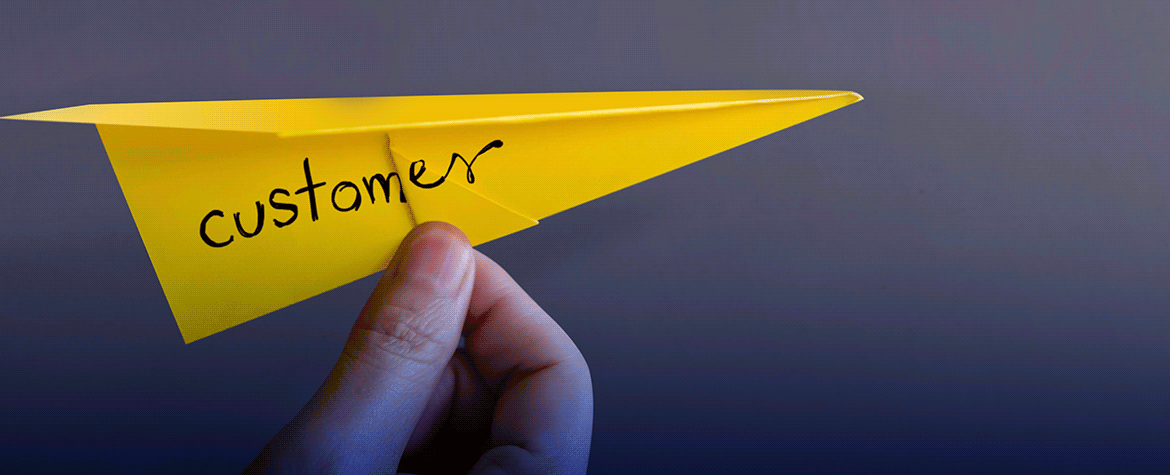It’s all well and good to release a great product, but sometimes customers need to be wooed into those final stages. With massive competition in the market and uncertainty about the best services, getting customers to understand the utility of your goods and services is crucial. That’s where customer journey management comes in.
First, we need to go over the basic theories at play, then we’ll talk about strategies for each area of the journey.
Customer Journey Stages
Think of the stages of the customer journey in terms of the Sales Funnel:
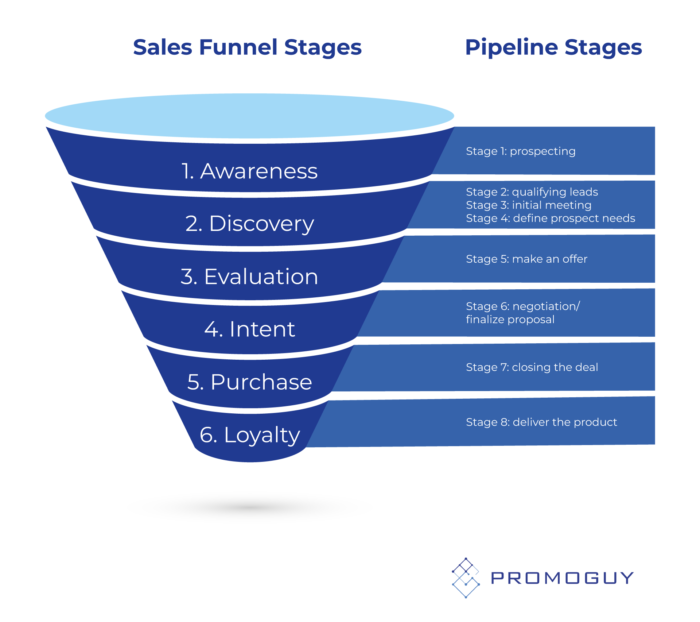
It can be useful to think of the various steps of the customer journey as analogous to the sales funny, but from the customer’s perspective:
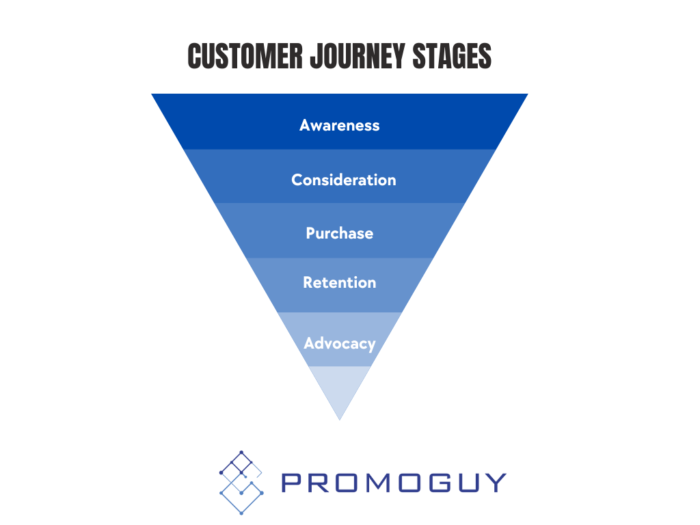
- Awareness: the customer knows your name or has a passing familiarity with your output.
- Consideration: the purchase intention is building within the customer and they are weighing their options in the market.
- Purchase: they are now ready to purchase the good of their choice but it’s not the end of the funnel yet.
- Retention: they want to remain a customer (this step is particularly important for services that run on recurring fees).
- Advocacy: the customer is now loyal and maybe even an evangelist for the brand or product.
While this is all theoretical, it comes into practice with other models in the field. One way to visualize the process is with a touchpoint journey map. These can be as simple as the example below:
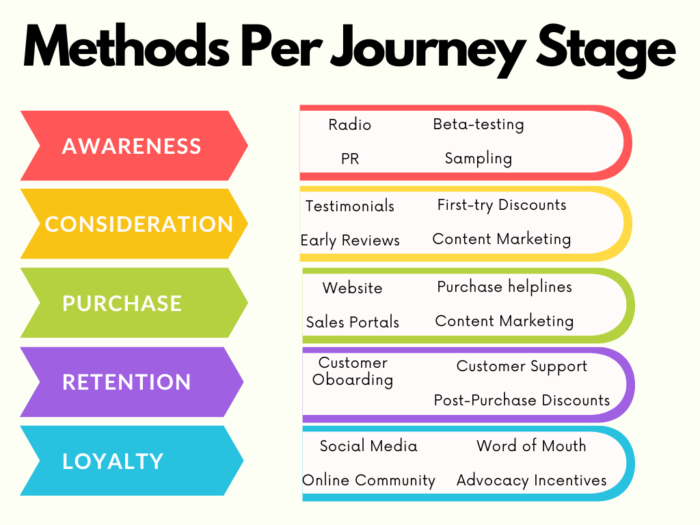
Or they can get a fair bit more complicated when businesses grow and need to manage more departments:
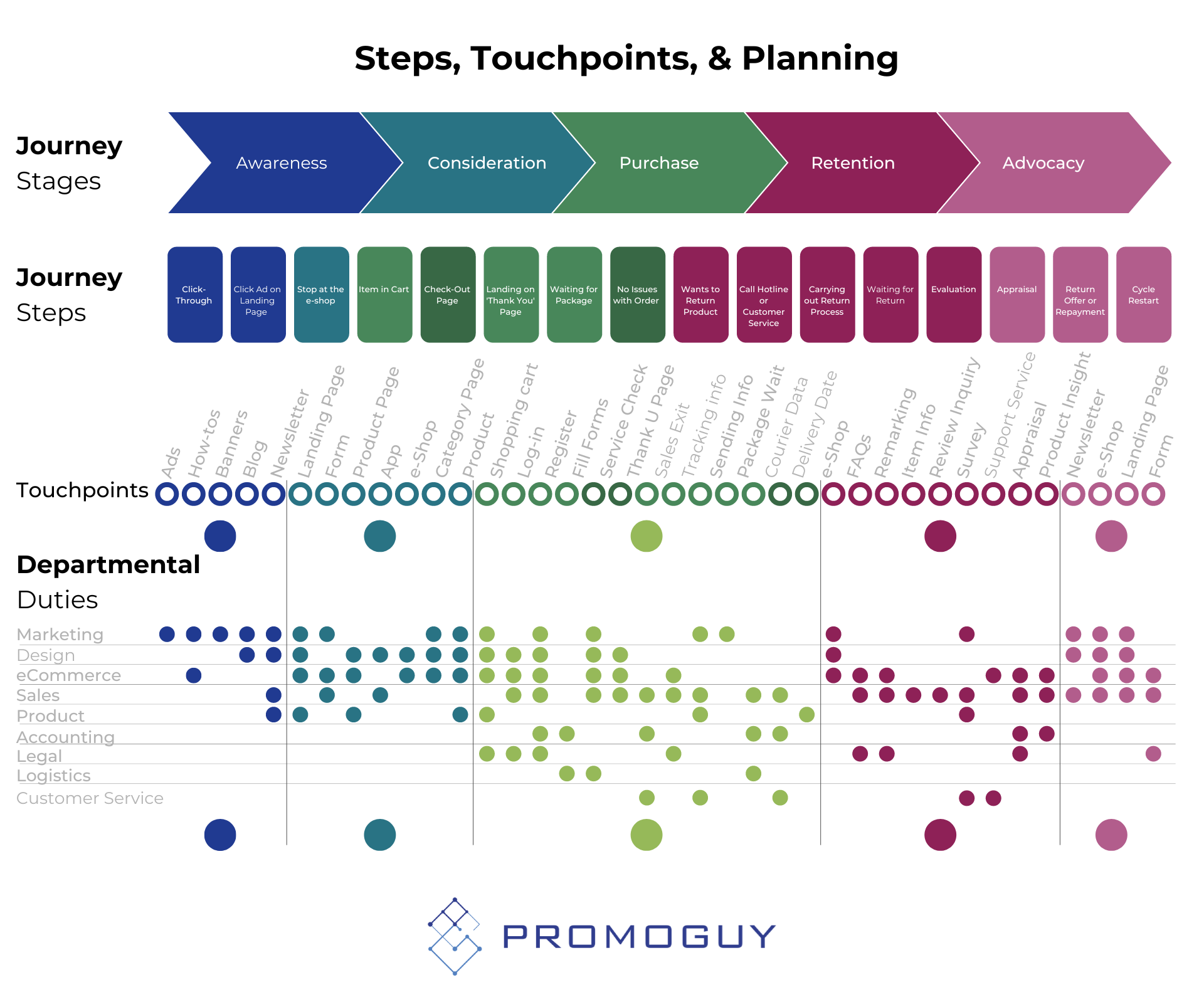
This map is particularly useful in ironing out the customer website journey and how to organize around each touchpoint.
Companies usually develop one that suits their specific purposes and workflow. For example, Amazon’s customer journey map is fairly different:
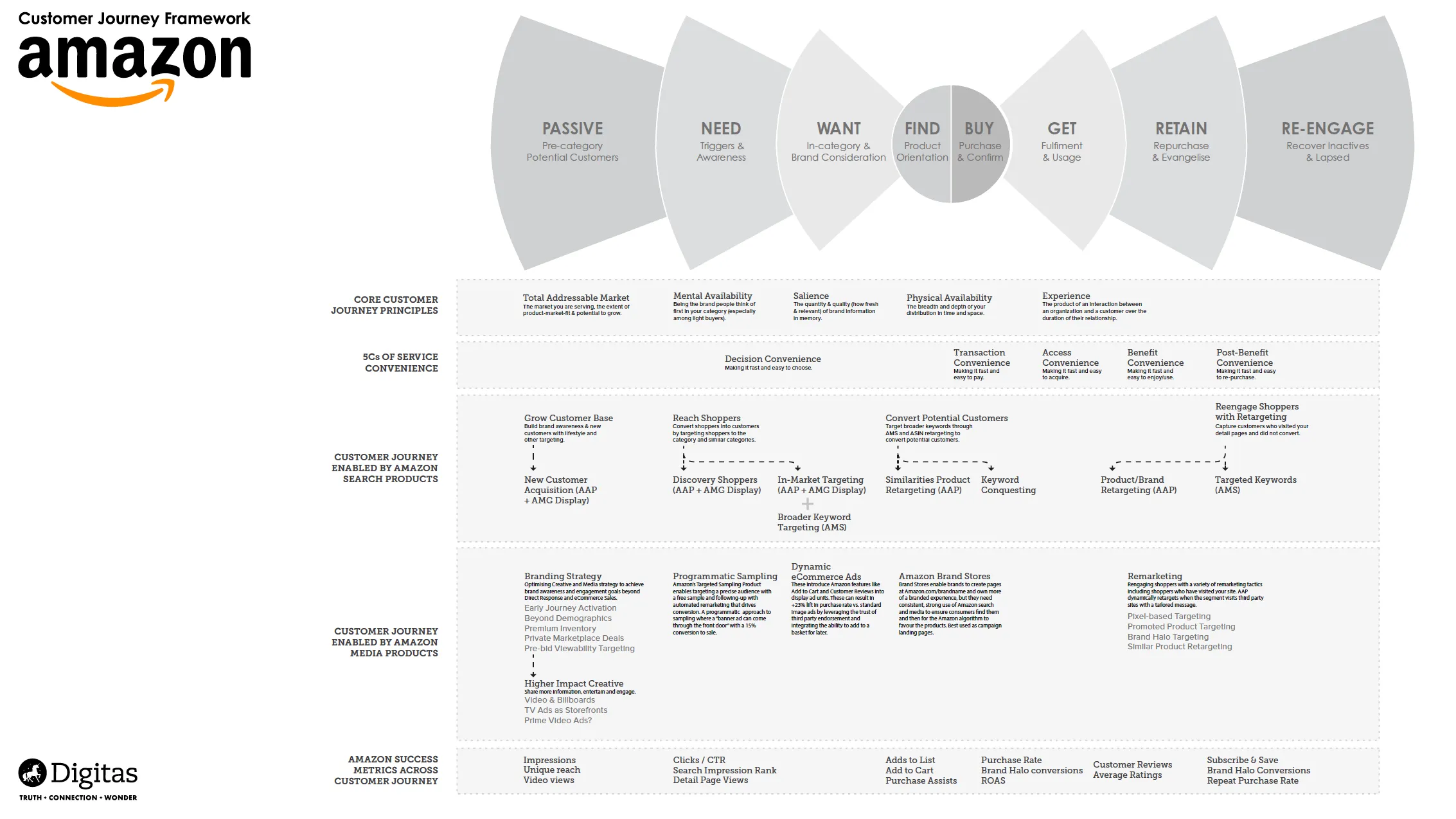
The point is to use these as starting points and make them your own.
B2B Customer Journey Stages
The B2B customer journey touchpoints are sometimes illustrated in a slightly different way. As some studies have indicated B2B buyers actively prefer to be shown content relevant to their current stage of the buyer’s journey.
In general, B2B journeys require a heavy emphasis on solid, rational information. They also need cognitive styles of marketing because (in some cases) emotional marketing can actually be off-putting to businesses.
Crafting a Customer Journey
Either way, use the one that most suits your current needs. The benefits of a customer journey map include the ability to lay out each step with touchpoints and channels, the ability to plan a strategy for different types of customers, and providing a performance review method that looks at steps with the customer experience of the journey’s stages in mind.
The customer journey’s benefits are also apparent in tapping into the minds of customers and preempting issues. That’s why the best way to map out a journey is with a buyer or customer persona.
Stage-Based Strategies for Funnel Management
Making sense of how to deal with each stage of the funnel is crucial for building a coherent journey map. In this section, we’ll break down generic marketing strategies that help at each stage. Keep in mind, generic strategies may not always work, but you need to know the basics to make informed decisions.
Customer Journey Awareness Stage
- How-tos: introduce your product and its utility to new users.
- Whitepapers: official documents can help garner early awareness.
- eBooks: publish an all-inclusive guide or other content to ease potential users into your product.
- Infographics: summarize your product in a visual aid that builds on any interest.
- Blogs: great for SEO and getting the foot in the door.
Consideration Stage
- Product Webinar: draw in interested parties.
- Case Study: show off the utility in real scenarios to seal the deal.
- Sample: provide some samples to the hesitant potential customers.
- FAQ: alleviate any concerns the customers may have early on.
- Data Sheet: some are convinced to purchase by stories others need hard numbers.
- Demo Video: visualise the product if possible (the Internet is increasingly a video medium, so capitalise on this expectation).
Purchase & Post-Purchase Stage
- Live Demo: show your customers how to use their products so they don’t return them.
- Consultation: keep the customer service lines active to keep your customers informed.
- Coupons: customers could receive additional purchase benefits to enhance their experience at a lower price than non-customers.
To further capitalise on post-purchase satisfaction, you can try out a few other methods:
- Surveys: grade what customers do and do not like about your services.
- Testimonial Requests: get testimonials from happy users to boost your content marketing.
- Follow-Up Satisfaction Phone Calls: check in on customers to see what would make them happier.
Building Loyalty & Advocacy
Loyalty and advocacy are all about creating an effective customer journey cycle. Here are some ways to reengage customers you think might be primed for loyalty and advocacy:
- Email marketing and customer journey reactivation: reach out to customers who’ve already bought your products with new offerings via email.
- Testimonial sharing: customers in this stage can be a great asset to your marketing efforts as they provide reviews (you can spice up the offer with discounts or other benefits).
- Community-building: create a discord server, a Reddit page, or other community options where new and old users can help each other out or share their love for the brand (more on community management here).
Customer Journey Automation Tools
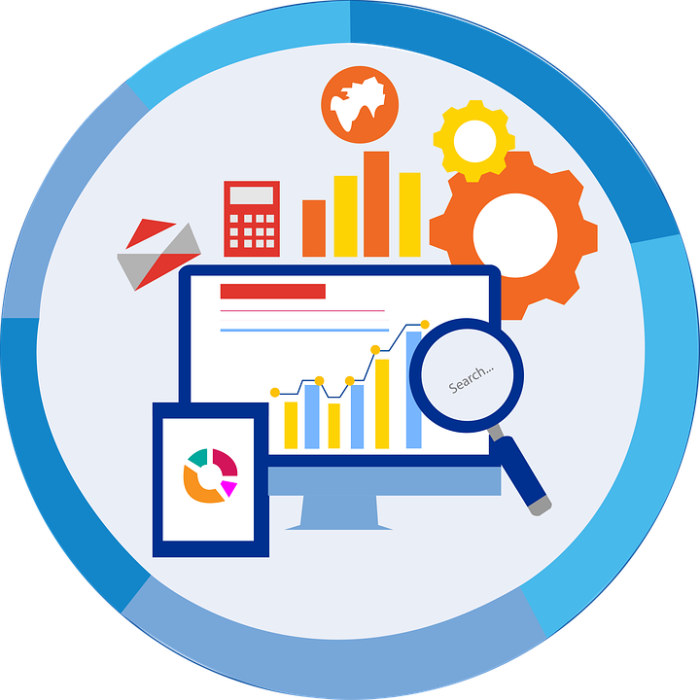
Setting up an automated customer journey provides your funnel with a smoothness of function while enhancing the capacity for data-gathering at each stage. Automation tools can help make the customer experience process flow better and allow you to focus on the quality of your work.
- MailChimp: great for email outreach especially with their journey builder. Particularly great for planning multiple campaigns at different journey stages.
- Microsoft Visio: a useful tool for visualizing UX processes and is easy to use while linking with other MS office applications.
- IBM Journey Designer: an application that offers the ability to create customer journeys in minutes with great collaborative tools that optimize teamwork.
- Asana: organize your teams and delegate tasks with ease across all areas of the funnel. Great for managing large teams and client bases.
Customer Journey Social Media Marketing
Social media marketing should enforce the customer journey at every significant point, from awareness to sale to post-purchase reinforcement. While there are no hard and fast rules, you need to think of it as a process that divides the market into separate customers.
- Find your prospective customer base and build a buyer persona.
- What platforms do they use the most?
- What social media messaging resonates with them?
- Level of competition per platform.
- Target social media ads and measure engagement.
- Identify the people who are already familiar with your product vs those who aren’t.
- Track your website, use Facebook pixel, and examine analytics.
- Look for unique visitors vs recurring visitors.
- Examine exit rates and where sessions are being ended to identify weaknesses in funnelling.
- For the awareness stage, you can try to target them with tutorial videos or introductions.
- For consideration, you may want to sweeten the deal with customer testimonials or even discounts.
- After purchase, the role of social media evolves into loyalty and advocacy.
- Engage in community-building through group forums like Reddit or Discord.
- Interact with the customer, solve their problems, and let them evangelise for the product.
- Ask for testimonials or reviews.
- Build hype for your next product or update within the community.
Customer Journey Analytics & Tactics for Improving Them
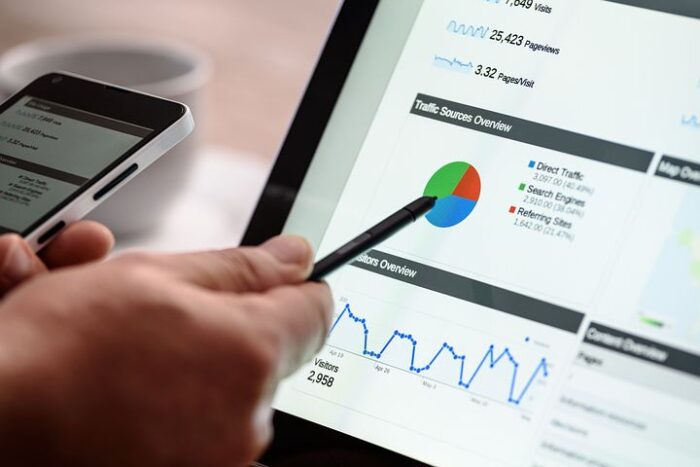
To aid the effort in your journey planning you also need to know where to look. Furthermore, you need to keep track of which stage of the funnel you’re in. Here are some crucial metrics to keep abreast of alongside your customer journey and when evaluating its effectiveness:
- Clicks & Impressions
The first step is to always keep track of how many hits your website is getting. Similarly, keep track of cost per click and cost per 1,000 impressions to measure effectiveness and marketing ROI. Improve CTR and Impressions with quality content, the right keywords, better geo-targeting or demographic targeting, and A/B testing your ads.
- Churn Rate
Make sure you know how many people are exiting your service or stopping using your goods too early. To improve on these numbers, you need to ask why they leave. Aside from improving the product, ask yourself whether you’re targeting the right customers and whether your customer service is helping them make good use of it.
- Bounce Rate, Exit Rate, Time per Session, & Pages per Visit
having a high bounce rate or exit rate can be a bad portent for certain pages but it’s not always a death sentence. Our primer on bounce rates and exit rates goes into detail on this. Briefly, you can improve the UX of the page, improve your customer targeting, add CTAs, make the desirable pages easier to access and improve page speeds.


